» posted on Wednesday, September 30th, 2015 by Linda Lou Burton
An Invite From CRAG
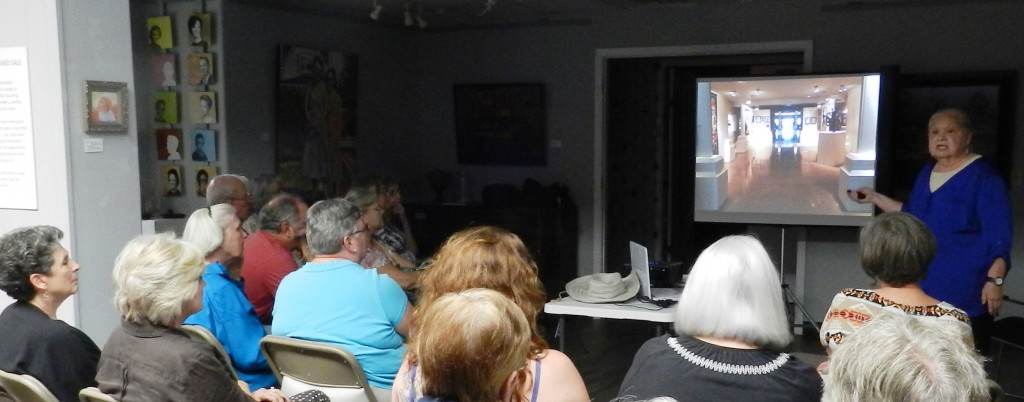 Linda Burton posting from Arkadelphia, Arkansas — I was invited to speak at the September 24 meeting of the Caddo River Art Guild (CRAG), an avid group whose mission is promoting art and artists in south central Arkansas, http://caddoriverartguild.com/. My mission of course is capital cities, so I talked about “art in the capital cities,” that is, the community’s support of the arts. How Art Thrives was my topic, leading with the question: What does it take to have a thriving arts community?
Linda Burton posting from Arkadelphia, Arkansas — I was invited to speak at the September 24 meeting of the Caddo River Art Guild (CRAG), an avid group whose mission is promoting art and artists in south central Arkansas, http://caddoriverartguild.com/. My mission of course is capital cities, so I talked about “art in the capital cities,” that is, the community’s support of the arts. How Art Thrives was my topic, leading with the question: What does it take to have a thriving arts community?
It takes four things, I proposed, to nods of agreement from around the room:
• Money
• Artists
• Volunteers
• Attitude
I selected five uniquely different cities to illustrate:
Santa Fe, New Mexico, Population 67, 947 (about 6 Arkadelphias) because it supports and focuses on the artist more than any other capital city.
Montpelier, Vermont, Population 7,855 (about 3/4 of 1 Arkadelphia!) because it’s the smallest capital city and has the 2nd most artists per capita and the biggest group of volunteers.
And Helena, Montana, Population 28,190 (about 3 Arkadelphias), Lincoln, Nebraska, Population 258,379 (about 24 Arkadelphias), and Indianapolis, Indiana, Population 820,444 (about 77 Arkadelphias) to show it’s not the size of the city that matters, it’s the attitude of its residents.
SANTA FE
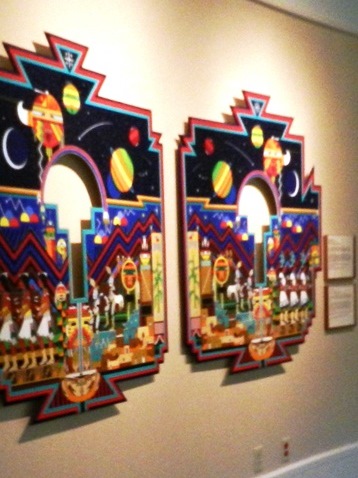 Santa Fe – the oldest capital and also the highest in elevation at 7,000 feet – has the fabulous Capitol Art Collection with 600 artworks from 600 New Mexico artists exhibited inside the capitol and on the grounds. It includes paintings, photography, works on paper, sculpture, mixed media, textiles, ceramics, glass, and furniture, and is valued at $6 million. All this is managed by the Capitol Art Foundation of New Mexico, which was founded in 1991 by the New Mexico Legislature with its mission to collect, preserve, exhibit, interpret, and promote appreciation of works of art that reflect the rich and diverse history, cultures, and art forms of the people of New Mexico. Cynthia Sanchez is Director and Curator of the Capital Art Collection, and all 600 pieces can be viewed online. www.nmcapitolart.org
Santa Fe – the oldest capital and also the highest in elevation at 7,000 feet – has the fabulous Capitol Art Collection with 600 artworks from 600 New Mexico artists exhibited inside the capitol and on the grounds. It includes paintings, photography, works on paper, sculpture, mixed media, textiles, ceramics, glass, and furniture, and is valued at $6 million. All this is managed by the Capitol Art Foundation of New Mexico, which was founded in 1991 by the New Mexico Legislature with its mission to collect, preserve, exhibit, interpret, and promote appreciation of works of art that reflect the rich and diverse history, cultures, and art forms of the people of New Mexico. Cynthia Sanchez is Director and Curator of the Capital Art Collection, and all 600 pieces can be viewed online. www.nmcapitolart.org
Santa Fe is one of the world’s foremost art destinations, an art world mecca. It’s the country’s third largest art market, selling more art than every city except New York and Los Angeles. It has 200-plus galleries. It has several major museums. And it features all artistic mediums and genres from centuries-old treasures to contemporary works.
I pointed out the four distinctive “arts” areas of the city that are not to be missed on every visit:
• Canyon Road – Santa Fe’s most famous street with over 100 galleries, boutiques and restaurants.
• Downtown – the heart of historic Santa Fe with galleries, restaurants, and the Palace of the Governor’s on the Plaza. The Georgia O’Keefe Museum and the New Mexico History Museum are downtown.
• Museum Hill – a shuttle runs from the downtown plaza to a hillside southeast of downtown where four museums display art of the Southwest and the world, from American Indian to Spanish Colonial to International Folklife.
• Railyard District – a 50-acre city-owned art district and community gathering spot with galleries and artist workspace.
MONTPELIER
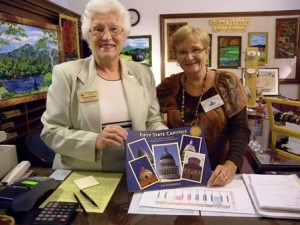 Moving clear across the country in time and space and historical background to Montpelier, the smallest capital city in population, I talked about the “Friends of the Vermont State House,” that all-volunteer organization of 120 men and women who lead tours, prepare events, newsletters, and educational materials, and organize and staff the gift shop in the capitol. The “Friends” are part of
Moving clear across the country in time and space and historical background to Montpelier, the smallest capital city in population, I talked about the “Friends of the Vermont State House,” that all-volunteer organization of 120 men and women who lead tours, prepare events, newsletters, and educational materials, and organize and staff the gift shop in the capitol. The “Friends” are part of 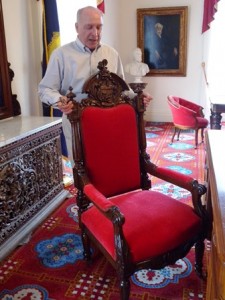 the Vermont State Curator’s Office, which oversees the restoration and care of the Vermont State House and the state’s collection of fine and decorative art and historic furniture. David Schutz is the Vermont State Curator. www.bgs.vermont.gov/curatorial
the Vermont State Curator’s Office, which oversees the restoration and care of the Vermont State House and the state’s collection of fine and decorative art and historic furniture. David Schutz is the Vermont State Curator. www.bgs.vermont.gov/curatorial
I pointed out that Montpelier is recognized as one of the best 100 small arts towns in the country, and that per capita, more writers and visual artists live in Vermont than in 48 other states; and more musicians and photographers live in Vermont than in 42 other states. Vermont’s terrain, culture, and location attract artists and those artists, in turn:
• infuse local politics
• inform social norms
• perpetuate a cycle of community building
The Vermont Arts Council is the state’s primary provider of funding, advocacy, and information for the arts in Vermont. Vermont Arts Council, www.vermontartscouncil.org
We picture-walked through downtown Montpelier’s tree-shaded streets, past bookstores and shops on sidewalks lined with benches and hanging flower baskets; and past the fabulous restaurants operated by NECI, the New England Culinary Institute. And then I took my audience on a tour of the local countryside, visiting the headquarters of Ben & Jerry’s Ice Cream and Green Mountain Coffee; the Rock of Ages marble quarry; a sugar maple farm, and a good old-fashioned cider mill.
No wonder so many artists are attracted to Vermont!
HELENA
 Back across the country to Helena, probably the most isolated capital city except for Juneau. But like Montpelier, it makes the list of best 100 small arts towns in the country. Helena is loaded with charm and humor and a sense of fun and play, nestled on the eastern side of the Rocky Mountains in a valley watched over by a formation known as The Sleeping Giant. For a history it has Lewis & Clark passing through on the Missouri River and gold rush ripping and roaring that produced more than 50 millionaires, back in the days.
Back across the country to Helena, probably the most isolated capital city except for Juneau. But like Montpelier, it makes the list of best 100 small arts towns in the country. Helena is loaded with charm and humor and a sense of fun and play, nestled on the eastern side of the Rocky Mountains in a valley watched over by a formation known as The Sleeping Giant. For a history it has Lewis & Clark passing through on the Missouri River and gold rush ripping and roaring that produced more than 50 millionaires, back in the days.
Of course you can’t talk about Montana without talking about Charles M Russell (1864-1926), 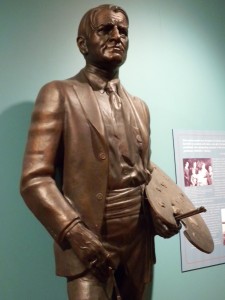 Montana’s Cowboy Artist. One of his paintings, “Lewis & Clark Meeting The Flathead Indians,” hangs on the wall behind the Speaker’s chair in the House Chambers of the Montana State Capitol; it is valued at over $1 million, but referred to as “priceless.” And here’s a story – when they realized (over the years) that the heat and cold on that outside wall were damaging the portrait, they simply built a double wall on that part of the capitol to protect the painting. Talk about treasuring your art, and artist!
Montana’s Cowboy Artist. One of his paintings, “Lewis & Clark Meeting The Flathead Indians,” hangs on the wall behind the Speaker’s chair in the House Chambers of the Montana State Capitol; it is valued at over $1 million, but referred to as “priceless.” And here’s a story – when they realized (over the years) that the heat and cold on that outside wall were damaging the portrait, they simply built a double wall on that part of the capitol to protect the painting. Talk about treasuring your art, and artist!
Across the street in the Montana Historical Society Museum are over 200 more pieces of Russell’s work —24 major oils, 33 major watercolors, 40 pen and inks, 15 original models, 60 bronzes, and 34 illustrated letters. www.mhs.mt.gov/Museum
The Archie Bray Foundation is another important part of the arts scene in Helena. Archie Bray Sr owned a brickyard named Western Clay Manufacturing and he was also a patron of the arts. In 1951 he created the Archie Bray Foundation to make “a fine place to work” for all interested in the ceramic arts. It was the first artist residency program in the US devoted solely to ceramics and today ceramic artists from around the world travel to Helena to work and study at “The Bray.” Archie Bray Foundation www.archiebray.org
Other resources for artists in Montana include the Montana Artrepreneur Program (MAP) offering opportunities for folk and traditional visual artists to learn how to build a sustainable business in art. Montana Arts Council www.art.mt.gov
LINCOLN
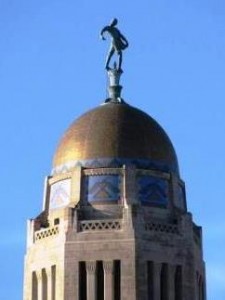 Next we went to a city of the vast prairie lands, Lincoln, Nebraska, where the capitol is a highrise but still is topped with a dome – gold gilded with a figure of “The Sower” on top, and filled to the brim with works of art. (See all http://capitol.nebraska.gov/building/rooms) I told about the day-camp kids visiting that day, and our story-telling tour guide, who explained not only the artist’s technique, but the story behind each art work as it relates to the history of Nebraska. The “team” who designed the capitol was composed of an architect, an artist, a sculptor, and a philosopher. These lines from Aristotle’s Politics are inscribed in stone on the rotunda walls: “A community like an individual has a work to do.”
Next we went to a city of the vast prairie lands, Lincoln, Nebraska, where the capitol is a highrise but still is topped with a dome – gold gilded with a figure of “The Sower” on top, and filled to the brim with works of art. (See all http://capitol.nebraska.gov/building/rooms) I told about the day-camp kids visiting that day, and our story-telling tour guide, who explained not only the artist’s technique, but the story behind each art work as it relates to the history of Nebraska. The “team” who designed the capitol was composed of an architect, an artist, a sculptor, and a philosopher. These lines from Aristotle’s Politics are inscribed in stone on the rotunda walls: “A community like an individual has a work to do.”
Lincoln is one of the most impressive capital cities when it comes to “community action,” and  I talked about the “Life is Right in Lincoln” campaign in the city, which states: All the factors that lead to a great life are right here. When I first heard that statement during my stay in Lincoln, I thought – now wait a minute! Lincoln wasn’t built near a large body of water or any mountains, it was barren prairie. It is bitter cold in the winter and blazing hot in the summer, with frequent tornadoes and blizzards. Does that sound like a good place to live?
I talked about the “Life is Right in Lincoln” campaign in the city, which states: All the factors that lead to a great life are right here. When I first heard that statement during my stay in Lincoln, I thought – now wait a minute! Lincoln wasn’t built near a large body of water or any mountains, it was barren prairie. It is bitter cold in the winter and blazing hot in the summer, with frequent tornadoes and blizzards. Does that sound like a good place to live?
Maybe they didn’t have a single tree when it was first settled, and they had to build houses out of sod. But today, look at these stats:
• Lincoln has 125,000 community-planted public trees and 6,000 acres of parks and natural land.
• City planners are building a public park within a half-mile of every residence in the community.
• Neighborhoods are marked with individually themed banners.
• Median strips are filled with flowers.
And, a footnote: Nebraska is the only state with a unicameral legislature. No partisanship!
Of course, the University of Nebraska impacts the city greatly, with its offerings of sports (Go Cornhuskers!) and cultural events and museums. I advised all of our Arkadelphia artists to visit the International Quilt Study Center & Museum for SURE when they’re in Lincoln. Imagine, more than 4,500 quilts and quilt-related objects representing 50 countries and four centuries of quiltmaking in a 50,000 square foot building with 3 exhibition galleries and state of the art climate controlled textile storage. Wow! www.quiltstudy.org
INDIANAPOLIS
Last stop on the art tour was the second-largest capital city in population, a big city that is easy to maneuver, and where I always managed to find a parking place. I had already blabbed for almost an hour by that part of my talk, so confined my remarks only to the public space and public art in Indianapolis.
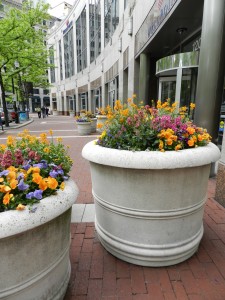 For space, Monument Circle of course, which has been named “One of Ten Best Public Spaces” by the American Planning Association. Since 1821 when Alexander Ralston laid out the state’s capital and located “Circle Street” in the middle of the mile square plat, Monument Circle has served as the literal and figurative center of Indianapolis, a natural gathering place. I took my audience on a walk around the Circle, noting the restaurants, office buildings, and even a church offering daily services, all spruced up with flowers and fountains and within two blocks of the capitol. And within two blocks of Indianapolis Artsgarden, an over-the-street space connecting the buildings on each of the surrounding four corners. Music, food, and a place to rest and gather, with a booth manned by the Arts Council guiding all who inquire to everything the city has to offer.
For space, Monument Circle of course, which has been named “One of Ten Best Public Spaces” by the American Planning Association. Since 1821 when Alexander Ralston laid out the state’s capital and located “Circle Street” in the middle of the mile square plat, Monument Circle has served as the literal and figurative center of Indianapolis, a natural gathering place. I took my audience on a walk around the Circle, noting the restaurants, office buildings, and even a church offering daily services, all spruced up with flowers and fountains and within two blocks of the capitol. And within two blocks of Indianapolis Artsgarden, an over-the-street space connecting the buildings on each of the surrounding four corners. Music, food, and a place to rest and gather, with a booth manned by the Arts Council guiding all who inquire to everything the city has to offer.
I was attracted to the story behind the 400 pieces of public art in Indianapolis – art that is not funded by the city or the council. I learned that artists are allowed to install their art in public spaces, and the Arts Council tracks and promotes it. The Council’s website has a photo of each piece, with directions on where it is located, and information about the artist. A true collaboration – the artist takes the initiative, the city allows the space, and the Arts Council promotes the work of art. All 400 pieces may be viewed online, Arts Council of Indianapolis www.indyarts.org
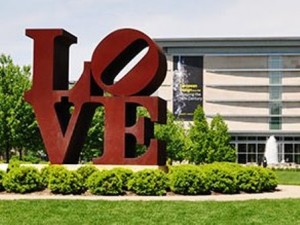 I closed my talk with a picture of the Indianapolis Art Museum, and the LOVE sculpture out front. Yes, you need Money, Artists, Volunteers, and the right Attitude to have a thriving arts community, but there is one more important ingredient, and that is LOVE.
I closed my talk with a picture of the Indianapolis Art Museum, and the LOVE sculpture out front. Yes, you need Money, Artists, Volunteers, and the right Attitude to have a thriving arts community, but there is one more important ingredient, and that is LOVE.
Because (as I’ve said before!) “It’s not what you’ve got that counts, it’s how much you love what you’ve got.”
What a nice crowd attended, and how wonderfully receptive they were! You know you’re doing okay when people laugh when you meant for them to, and when nobody nods off (or heaven forbid leaves). I had great fun preparing the slides as I remembered my adventures in each place. Of course, I would love to talk about all fifty capitals every time, but, that happens on the Web Site you’re looking at now.
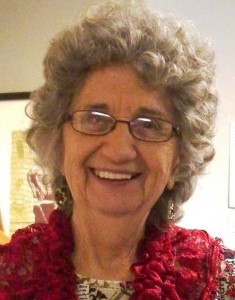 I love the arts community here in Arkadelphia and am proud to be involved with the hardworking, talented, and enthusiastic people who have welcomed me in. The Director of the Arts Center, Farrell Ford, is one of the first friends I made in my first month in town. She is an amazing woman who works tirelessly to find artists in our community, to encourage them, and to promote the dickens out of them. Good job, Farrell, and all CRAG officers and members and volunteers and sponsors.
I love the arts community here in Arkadelphia and am proud to be involved with the hardworking, talented, and enthusiastic people who have welcomed me in. The Director of the Arts Center, Farrell Ford, is one of the first friends I made in my first month in town. She is an amazing woman who works tirelessly to find artists in our community, to encourage them, and to promote the dickens out of them. Good job, Farrell, and all CRAG officers and members and volunteers and sponsors.
Thank you for having me.
Here is the slide presentation in a PDF format, see all the photos:
CRAG PRESENTATION F 09.24.2015
Here is the handout in a PDF format, with links to 15 interesting artistic spots in each of the 5 capital cities:
ABOUT THE CADDO RIVER ART GUILD
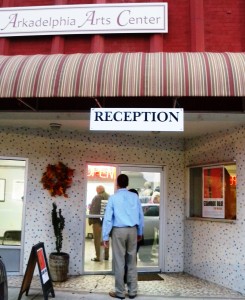 Mission: to promote art and artists in south central Arkansas and to generate appreciation and continued interest in all mediums of artwork. Membership is open to anyone interested in producing or learning about art and promoting local artists and their work.
Mission: to promote art and artists in south central Arkansas and to generate appreciation and continued interest in all mediums of artwork. Membership is open to anyone interested in producing or learning about art and promoting local artists and their work.
This avid group of artists conducts monthly meetings on the third Thursday of each month at the Arkadelphia Arts Center, 625 Main Street. They provide classes and workshop demonstrations throughout the year.
What a great group of people, and an enthusiastic, talented, and hardworking group of artists!
The Calendar of Events lists the exciting Round About Artist Studio Tour on Oct. 16th, 17th, and 18th.
Read about the Guild: http://caddoriverartguild.com/
Read about the Tour: http://caddoriverartguild.com/TourHome.htm
Don’t miss it!
CRAG Board Members
President: Farrell Ford
Vice President Publicity: Hank Armstrong
Secretary: Evelyn Good
Treasurer: Rita Earles
At Large: Mike Uhl

